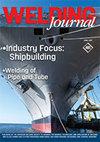核设施用30%铬镍合金无裂纹焊接产品
IF 2.2
3区 材料科学
Q2 METALLURGY & METALLURGICAL ENGINEERING
引用次数: 0
摘要
在开发30%铬镍合金核焊丝方面的前期研究,解决了一次水应力腐蚀开裂(PWSCC)和延性浸裂(DDC)问题,提高了抗凝固开裂(SC)能力。DDC的分辨率表现出一定的Laves相,这对SC电阻有负面影响。本文研究了钽(Ta)与铌(Nb)复合的替代碳化物原体的使用。对新设计的52MSS-Ta填充金属(HV1648、HV1673A、VX131WXW)进行了熔解、制备和系统研究。采用Scheil凝固模拟模型、两种变应变试验和应变-断裂(STF)试验对DDC和SC进行热力学建模。变约束和STF测试结果表明,该材料的SC电阻有所提高,Laves相位降低,同时具有优异的DDC电阻。优化后的低Laves相组合物在STF测试中也表现出较高的阈值应变值(tsv)。VX131WXW含有2.81 wt-%的Ta, 0.6 wt-%的Nb和6 wt-%的铁(Fe), TSV为24%。thermal - calc计算出VX131WXW的Laves相为0.24%,而HV1673A的Laves相为0.06%。在纵向变应变测试中,与HV1673A相比,Laves相位的差异导致VX131WXW的SC电阻较低。HV1673A的最大裂纹距离约为0.6 mm,热VX131WXW的最大裂纹距离约为1.0 mm。典型的VX131WXW稀释焊层由于铬含量超过24%,也能抵抗PWSCC。这些结果标志着无裂纹焊接的进展,并为进一步优化含ta填充金属提供了方向。本文章由计算机程序翻译,如有差异,请以英文原文为准。
Crack-Free 30% Chromium-Nickel Alloy Welding Products for Nuclear Service
Prior research in the development of 30% chromium-nickel alloy nuclear welding wires has resulted in the resolution of primary water stress corrosion cracking (PWSCC) and ductility dip cracking (DDC) as well as improvement in solidification cracking (SC) resistance. The resolution of DDC exhibits some Laves phase, which has a negative effect on SC resistance. In this study, the use of an alternate carbide former, tantalum (Ta), in combination with niobium (Nb) was researched. Three heats of recently designed Filler Metal 52MSS-Ta (i.e., HV1648, HV1673A, and VX131WXW) were melted, fabricated, and systematically studied. DDC and SC were evaluated with thermodynamic modeling using the Scheil solidification simulation model, two types of varestraint tests, and strain-to-fracture (STF) testing. The varestraint and STF test results showed an improved SC resistance with reduced Laves phase and concurrent excellent DDC resistance. Optimized compositions with low Laves phase also exhibited high threshold strain values (TSVs) in the STF test. VX131WXW — which contains 2.81 wt-% Ta, 0.6 wt-% Nb, and 6 wt-% iron (Fe) - exhibited a TSV of 24%. Thermo-Calc computed the Laves phase to be 0.24% for VX131WXW compared to 0.06% in HV1673A. This difference in Laves phase resulted in the lower SC resistance of VX131WXW compared to HV1673A when measured with longitudinal varestraint testing. The maximum crack distance for HV1673A was about 0.6 mm while that of heat VX131WXW was about 1.0 mm. The typical diluted weld deposit made with VX131WXW was also resistant to PWSCC due to the chromium content exceeding 24%. These simultaneous results mark progress toward crack-free welds and provide direction for further optimization of Ta-containing filler metals.
求助全文
通过发布文献求助,成功后即可免费获取论文全文。
去求助
来源期刊

Welding Journal
工程技术-冶金工程
CiteScore
3.00
自引率
0.00%
发文量
23
审稿时长
3 months
期刊介绍:
The Welding Journal has been published continually since 1922 — an unmatched link to all issues and advancements concerning metal fabrication and construction.
Each month the Welding Journal delivers news of the welding and metal fabricating industry. Stay informed on the latest products, trends, technology and events via in-depth articles, full-color photos and illustrations, and timely, cost-saving advice. Also featured are articles and supplements on related activities, such as testing and inspection, maintenance and repair, design, training, personal safety, and brazing and soldering.
 求助内容:
求助内容: 应助结果提醒方式:
应助结果提醒方式:


